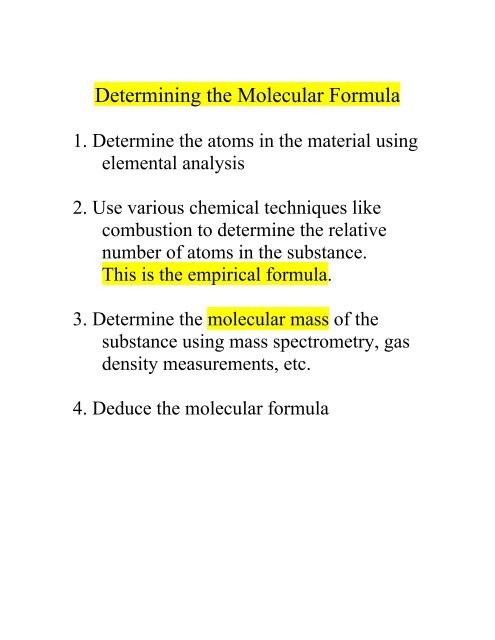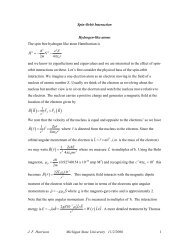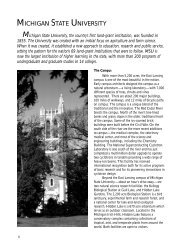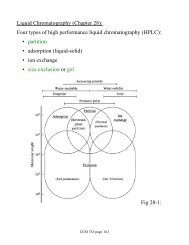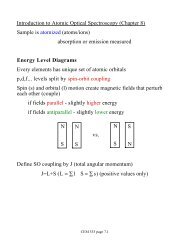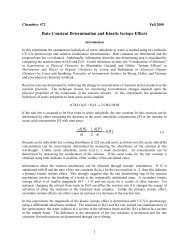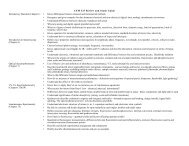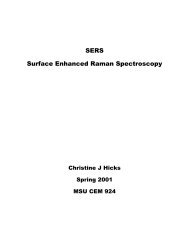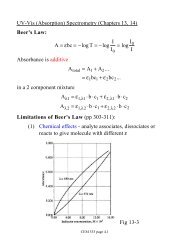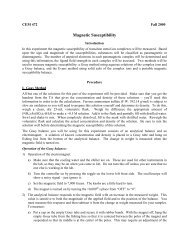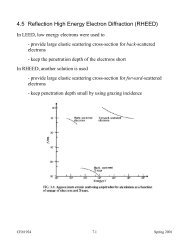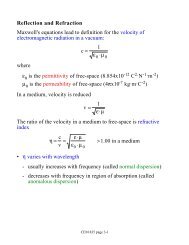Determining the Molecular Formula
Determining the Molecular Formula
Determining the Molecular Formula
You also want an ePaper? Increase the reach of your titles
YUMPU automatically turns print PDFs into web optimized ePapers that Google loves.
<strong>Determining</strong> <strong>the</strong> <strong>Molecular</strong> <strong>Formula</strong>1. Determine <strong>the</strong> atoms in <strong>the</strong> material usingelemental analysis2. Use various chemical techniques likecombustion to determine <strong>the</strong> relativenumber of atoms in <strong>the</strong> substance.This is <strong>the</strong> empirical formula.3. Determine <strong>the</strong> molecular mass of <strong>the</strong>substance using mass spectrometry, gasdensity measurements, etc.4. Deduce <strong>the</strong> molecular formula
Empirical / <strong>Molecular</strong> <strong>Formula</strong>sDetermine <strong>the</strong> empirical formula of <strong>the</strong>compounds with <strong>the</strong> followingcompositions:a. 0.0130 mol C, 0.0390 mol H,and 0.0065 mol Ob. 11.66 g iron and 5.01 g oxygenc. 40 % C, 6.7 % Hand 53.3 % O by massWhat is <strong>the</strong> molecular formula of each of <strong>the</strong>following compounds?a. empirical formula CH 2 ,molar mass = 84 g/molb. empirical formula NH 2 Cl,molar mass = 51.5 g/mol
<strong>Molecular</strong> formula from combustionGiven that <strong>the</strong> material contains C, H & OBurn 0.225 g of C x H y O zC H O + O(g) → CO(g) + H O(g)x y z2 2 2form 0.209 g H 2 O & 0.512 g CO 21. The number of moles of CO 2 is <strong>the</strong>number of moles of C in C x H y O z2. The number of moles of H 2 O is twice <strong>the</strong>number of moles of H in C x H y O z3. The number of moles of O in C x H y O zmust be determined by difference.
0.512gmoles of CO = 00116 . mol244.01 g/mol =0.209gmole of HO2= 0. 0116 mol18.00g/mol =grams of C = 0.0116(12.00) = 0.1392grams of H = 2(0.0116)(1.00) = 0.0232grams of O = 0.225 – 0.1392 – 0.0232 = 0.061
moles O =0.061g16.00g/mol =0.0038 molatoms of C relative to O = 0.0116/0.0038 = 3.04atoms of H relative to O = 0.0232/0.0038 = 6.08C 3 H 6 O<strong>Formula</strong> Mass is 58.09<strong>Molecular</strong> mass as 116 g/molC 6 H 12 O 2
Limiting ReactantsReaction will stop when one of <strong>the</strong> reactantsis gone3H (g) + N (g) → 2NH (g)2 2 3How many moles of product will result from3.0 mol N 2 and 6.0 mole H 23.0 mol N 2 can use 9.0 mol H 2 , have 6.06.0 mol H 2 can use 2 mol N 2 , have 3.0All H 2 will be consumed and so it is <strong>the</strong>limiting reactant
Given <strong>the</strong> reaction2Na PO ( aq ) + 3Ba( NO ) ( aq ) → Ba ( PO ) ( s ) + 6NaNO ( aq )3 4 3 2 3 4 2 3350 . g Na3PO 4and 6.40g Ba(NO3) 2How many grams of Ba3(PO 4)2will be formed?Which species is <strong>the</strong> limiting reactant?Compound3 43 2MolesNa PO 0.0213Ba(NO ) 0.0245Ba(NO3) 2is limiting reactantMoles of Ba (PO ) formed3 4 21 moles of Ba(NO3 )2 reacted3which is 0.00816
Concentration of Solutionsmolarity=moles of soluteliters of solutionM=nLMolarity of solution prepared by mixing23.4g of Na 2 SO 4 with enough water to makea solution whose volume is 125ml?<strong>Formula</strong> weight of Na2SO 4is 142.0 g/mol23. 4 / 142.0M = = 132 .0.125
Dilution ProblemGiven a solution with a known molarity oneis to dilute it to form a solution of a lessermolarity.Given a 1.00M solution of CuSO 4 , make250ml of a 0.1M solution.How many moles of CuSO 4 do we need?n = ( 0250 . )x( 01 . ) = 0025 . molWhat volume of <strong>the</strong> 1.0M solution containsthis amount ?0025 . molV = = 0.025L100 . mol / LAdd 25ml of 1.00M solution to 225ml of water
TitrationThe process of reacting a solution of anunknown concentration with one of a knownconcentrationOne can determine <strong>the</strong> Cl - concentration in awater sample by titrating with AgNO 3 .+ −Ag ( aq ) + Cl ( aq ) → AgCl( s )How many grams of Cl - are present in asample if 20.2 ml of 0.100M Ag + is neededto react with all of <strong>the</strong> Cl - ?moles Ag + = moles Cl -moles Ag + = (0.100mol/L)(0.020L) =0.0020 molg of Cl - = (0.0020 mol)(35.5g/mol) = 7.17 x 10 -2


